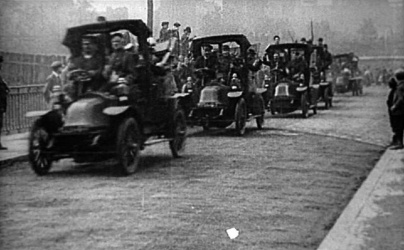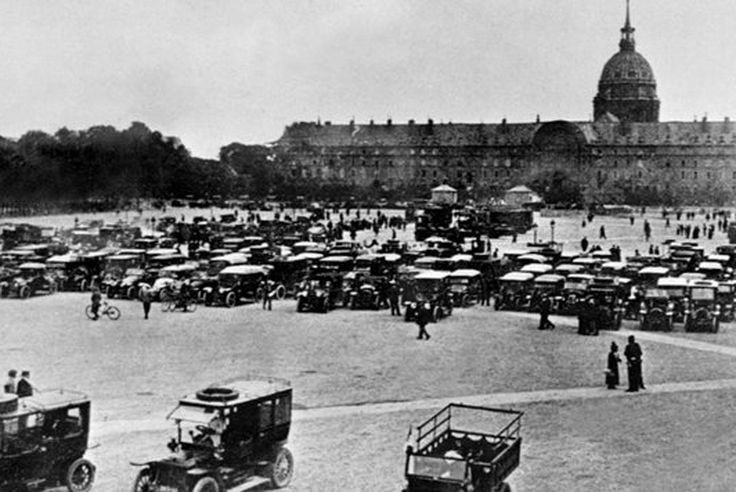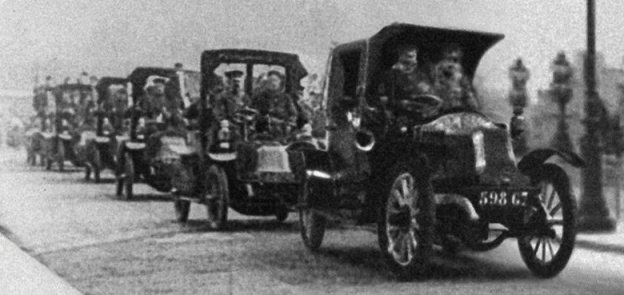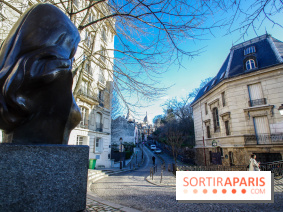On September 6 and 7, 1914, when theGerman army had crossed the Marne, theFrench general staff requisitioned 1,300 Parisian cabs, due to a lack of trains, in order to quickly send infantry troops to reinforce the front line and halt the enemy breakthrough. This was the"Marne cab" affair.
Since the beginning of September, French troops have been struggling at the front, while the enemy has been getting dangerously close to the capital and gaining the upper hand in the first weeks of the First World War. Under threat of bombardment, the government left Paris for Bordeaux.
September 5 saw the start of the first battle of the Marne, north-east of the capital, which could well fall to the Germans if the Allies fail. On the left bank of the river, the French and British armies faced the enemy troops, present in large numbers on the opposite bank. The 300km-long front pitted 900,000 German soldiers against a million French and British, with five battles being fought simultaneously on the battlefield.
But the situation was critical. General Joseph Joffre , commander-in-chief of operations for the French army, drew up an order of the day on the evening of September 5, to be issued at 7:30 a.m. on September 6: "As we embark on a battle on which the fate of the country depends, it is important to remind everyone that now is not the time to look back. Every effort must be made to attack and drive back the enemy. A troop that can no longer advance must, at all costs, hold the ground it has conquered and be killed on the spot rather than retreat. In the present circumstances, no failure can be tolerated."
Faced with the general's firmness, and with German uhlans reported only a few dozen kilometers from Paris, General Joseph Gallieni, military governor of Paris, General Jean-Baptiste Clergerie, and André Walewski, founder of the Compagnie française des automobiles de place, had a brilliant idea to reinforce General Maunoury 's 7th Army , on the extreme left of the Allied position, against the 1st Army of German commander Alexandre Von Kluck.
So, in order to quickly send French troops to reinforce their position close to the battlefield and carry out a major operation aimed at containing and destroying the German vanguards, the French general staff decided to requisition Parisian cabs , as the rail networks around Paris were insufficient, more or less saturated and often disorganized.
The idea is not, in fact, a new one. At the end of August 1914, car cabs had already been used to supply the entrenched camp of Paris, under the initiative ofIntendant General Burguet. Since then, General Gallieni has had a permanent reserve of 150 cabs available day and night, which can be tripled in a matter of hours - the capital actually has 10,000 cabs, but 7,000 drivers have already been mobilized for the war.
On the night of Sunday September 6 to Monday September 7, 1914, 630 Parisian cabs, mostly Renault AG-1 Landaulets, gathered in the courtyard of the Invalides. Travelling at 25km/h, each cab can carry up to five men and their packs. This first convoy heads for Tremblay-Lès-Gonesse and Mesnil-Amelot before reaching Livry-Gargan and Sevran-Livry, while a second convoy of 700 vehicles leaves the Invalides later in the day for Gagny.
Arriving at the rallying point, the cabs took on board 6,000 infantrymen from the 14th Brigade of the 7th Infantry Division commanded by General Edgard de Trentinian. On Monday night, September 7, the two battalions of the 104th R.I. landed at Nanteuil-le-Haudoin in the Oise department, closely followed by the three battalions of the 103rd R.I., which landed at dawn on September 8 at Silly-le-Long, south of Nanteuil-le-Haudoin.
Once the soldiers had been dropped off near the Marne front, the cab drivers returned to Paris, and the companies were paid 70,102 francs by the Ministry of War, the same price as for regular fares.
Although the episode of the Taxis de la Marne was not decisive for the First Battle of the Marne, the initiative nonetheless helped to halt the advance of enemy troops, and left its mark on history and on people's minds less in military terms than in psychological terms. Thanks to their unprecedented scale and the commitment of the local population, the " Taxis de la Marne " became part of legend, rapidly becoming a symbol of solidarity, unity and national determination.
Several Marne cabs have been acquired to perpetuate the memory of this legendary event: two Renault G7s can be seen at the Musée de l'Armée, located in the Hôtel des Invalides, and at the Musée de la Grande Guerre, in Meaux.
Location
Hôtel national des Invalides
129 Rue de Grenelle
75007 Paris 7



























